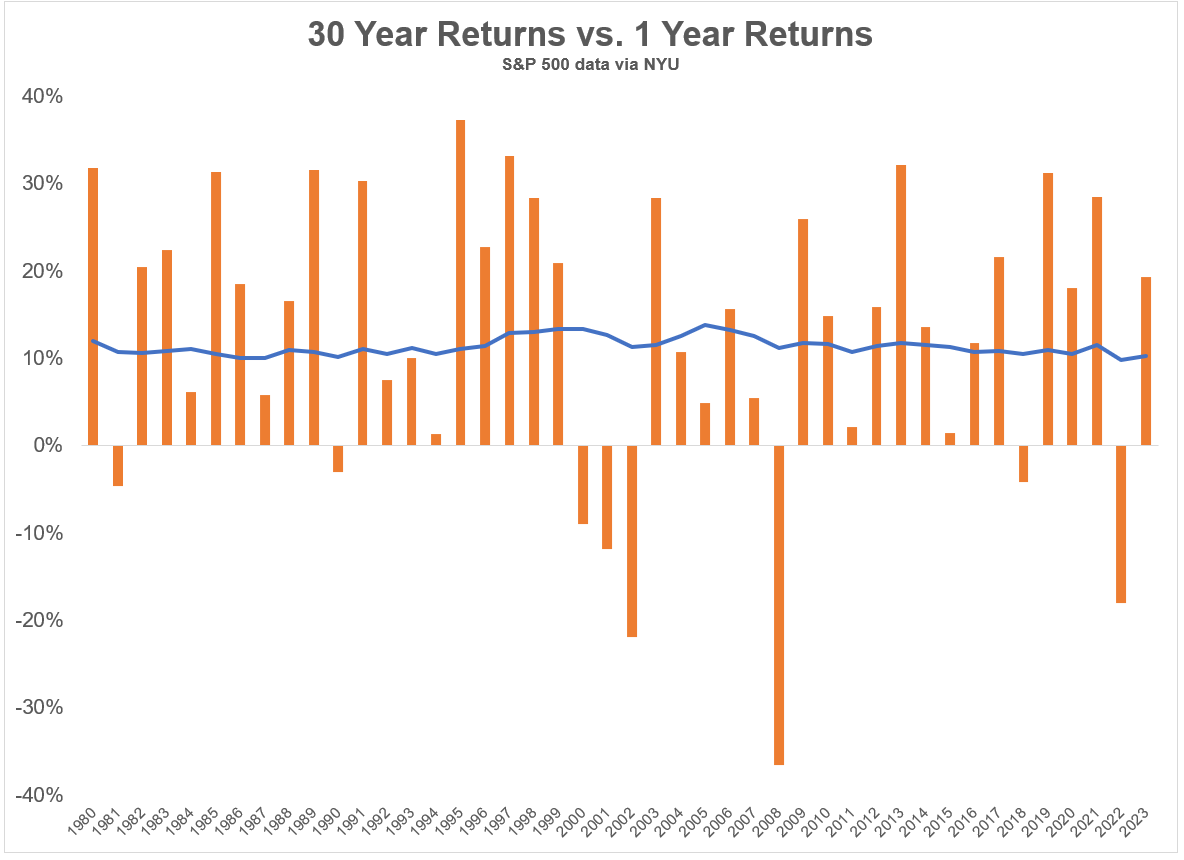One Year Returns Don’t Matter
A longer, more correct title, for this note would be, “One Year Returns Don’t Matter to Humans That Are Able to Ignore 20% Drawdowns.” But that headline is too long so we went with the same, short title used by Ben Carlson in his recent blog post.
In this chart, the orange bars represent annualized returns from 1980 – YTD 2023. The blue line represents the rolling 30-year return on the S&P 500 since 1950. The orange lines are all over the place. Some years we had great returns, other years we had terrible returns. Despite this annual volatility, the long-term average performance was remarkably consistent whether you got in at the best time or the worst.
But I Don’t Have 30 Years!
I’ve written similar notes before (citing different charts) and the response is always something like, “Stocks for the long run is a great concept BUT I’m retired, and I don’t even have the confidence to buy green bananas.”
To that point, let me preemptively remind you of three things.
People tend to live longer than they expect. For a married couple where the husband and wife are both 65, non-smoking, and generally healthy, there is a 50% chance one lives beyond age 91 and a 25% chance one lives beyond 96.
The money you need for spending purposes should not be invested in the stock market. If you need to pull $50k / year from your portfolio to cover living expenses, you should have something between $100k - $500k (2 – 10 years of spending money depending on your risk tolerance) held in high quality, short-duration investments that you could draw from as you wait for the stock market to recover. Stocks for the long run doesn’t work if you are forced to sell when they are down.
For our clients that tend to grow their wealth in retirement rather than spend down their principal, most of the portfolio will be left to surviving family members or charities with longer investment horizons. In that scenario, it often makes sense to invest the capital how you would suggest the beneficiaries invest for themselves.
Stock investing is one of those things that is both simple and incredibly difficult. Staying on course sounds easy in isolation, but there is always something to worry about.
Politicians are going to get elected, companies are going to fail, geopolitical issues will arise, legislation will get passed, recessions will occur, interest rates will change, and things will happen that we could never anticipate. Fortunately, in that sense, the future is likely no different than the past. As Ben Carlson concludes, “successful investing is for patient people.”





When it comes to writing about investments, the disclaimers are important. Past performance is not indicative of future returns, my opinions are not necessarily those of TSA Wealth Management and this is not intended to be personalized legal, accounting, or tax advice etc.
For additional disclaimers associated with TSA Wealth Management please visit https://tsawm.com/disclosure or find TSA Wealth Management's Form CRS at https://adviserinfo.sec.gov/firm/summary/323123